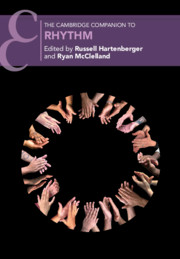Book contents
- The Cambridge Companion to Rhythm
- Cambridge Companions to Music
- The Cambridge Companion to Rhythm
- Copyright page
- Contents
- Figures
- Tables
- Music Examples
- Notes on Contributors
- Acknowledgments
- Introduction
- Part I Overview of Rhythm
- Part II Performing Rhythm
- 3 Visualizing the Rhythms of Performance
- 4 A Percussionist Understands Rhythm in Five Essays of Exactly 1,000 Words Each Not Including Titles and Subtitles
- 5 A Different Kind of Virtuosity
- 6 Conducting Rhythm
- Part III Composing with Rhythm
- Part IV Rhythm in Jazz and Popular Music
- Part V Rhythm in Global Musics
- Part VI Epilogue
- Select Bibliography
- Index
3 - Visualizing the Rhythms of Performance
from Part II - Performing Rhythm
Published online by Cambridge University Press: 18 September 2020
- The Cambridge Companion to Rhythm
- Cambridge Companions to Music
- The Cambridge Companion to Rhythm
- Copyright page
- Contents
- Figures
- Tables
- Music Examples
- Notes on Contributors
- Acknowledgments
- Introduction
- Part I Overview of Rhythm
- Part II Performing Rhythm
- 3 Visualizing the Rhythms of Performance
- 4 A Percussionist Understands Rhythm in Five Essays of Exactly 1,000 Words Each Not Including Titles and Subtitles
- 5 A Different Kind of Virtuosity
- 6 Conducting Rhythm
- Part III Composing with Rhythm
- Part IV Rhythm in Jazz and Popular Music
- Part V Rhythm in Global Musics
- Part VI Epilogue
- Select Bibliography
- Index
Summary
Traditional staff notation provides a quantized view of musical time: rhythm symbols place each note at a fixed position within a metric framework consisting of integer multiples and fractions of the beat. This familiar representation of rhythm conceals the temporal elasticity of music in performance, including the nuances of tempo rubato in Western art music as well as the distinctive rhythmic irregularities in other musical traditions, such as the unequal or “swung” eighth-note subdivisions of jazz and blues and the speech-like rhythms of hip hop and other genres of groove-based music. To promote a clearer understanding of such rhythmic practices, collectively known as expressive timing or microtiming, several new methods of visualizing rhythm have been proposed over the past century, both in the context of Western art music – the focus of this chapter – and in other contexts.
- Type
- Chapter
- Information
- The Cambridge Companion to Rhythm , pp. 41 - 60Publisher: Cambridge University PressPrint publication year: 2020



